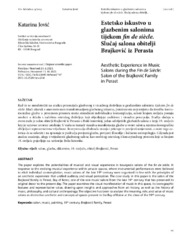Estetsko iskustvo u glazbenim salonima tijekom fin de siècle. Slučaj salona obitelji Brajković iz Perasta
Aesthetic Experience in Music Salons during the Fin de Siècle: Salon of the Brajković Family in Perast
| dc.creator | Jović, Katarina | |
| dc.date.accessioned | 2024-01-03T22:59:29Z | |
| dc.date.available | 2024-01-03T22:59:29Z | |
| dc.date.issued | 2023 | |
| dc.identifier.issn | 1848-1590 | |
| dc.identifier.uri | http://reff.f.bg.ac.rs/handle/123456789/5982 | |
| dc.description.abstract | Rad će se usredotočiti na analizu potencijala glazbenog i vizualnog doživljaja u građanskim salonima tijekom fin de siècle. Idući ukorak s onovremenom transformacijom glazbenog iskustva, potaknutom uvjerenjima da izvedba instrumentalne glazbe u privatnom prostoru može stimulirati individualnu kontemplaciju, saloni krajem stoljeća postaju uređeni u skladu s načelima estetskog doživljaja koji objedinjuje auditivnu i vizualnu percepciju. Studija slučaja u ovom radu je salon obitelji Brajković iz Perasta u Boki kotorskoj, jedan od rijetkih glazbenih salona s kraja 19. stoljeća koji je sačuvao izvorno uređenje. U radu se tumači vizualna manifestacija glazbe u ovom salonu, njezina ikonografska obilježja i reprezentativna vrijednost. Interpretacija obuhvaća znanja i pristupe iz povijesti umjetnosti, a osim toga autorica će se osloniti i na spoznaje iz područja povijesti glazbe, povijesti filozofije i kulturne antropologije. Cilj rada jest analiza značenja, uloge i vrijednosti glazbenog salona kao osobitog estetskog i konceptualnog prostora koji se krajem 19. stoljeća pojavljuje na teritoriju Boke kotorske. | sr |
| dc.description.abstract | The paper explores the potentialities of musical and visual experience in bourgeois salons of the fin de siècle. In response to the evolving musical experience within private spaces, where instrumental performances were believed to elicit individual contemplation, music salons of the late 19th century were organised in line with the principles of an aesthetic experience that unified auditory and visual perception. The case study in this paper is the salon of the Brajković family in Perast, Bay of Kotor, one of the rare music salons from the late 19th century that has preserved its original decor to the present day. The paper examines the visual manifestation of music in this space, its iconographic features and representative value, drawing upon insights and approaches from art history, as well as the history of music, philosophy, and cultural anthropology. The objective has been to analyse the meaning, role, and value of music salons as distinctive aesthetic and conceptual spaces present in the Bay of Kotor at the close of the 19th century. | sr |
| dc.language.iso | hr | sr |
| dc.publisher | Odjel za povijest umjetnosti Sveučilište u Zadru, Hrvatska | sr |
| dc.rights | openAccess | sr |
| dc.rights.uri | https://creativecommons.org/licenses/by/4.0/ | |
| dc.source | Ars Adriatica | sr |
| dc.subject | salon | sr |
| dc.subject | glazba | sr |
| dc.subject | slikarstvo | sr |
| dc.subject | 19. stoljeće | sr |
| dc.subject | obitelj Brajković | sr |
| dc.subject | Perast | sr |
| dc.subject | music | sr |
| dc.subject | painting | sr |
| dc.subject | 19th century | sr |
| dc.subject | Brajković family | sr |
| dc.title | Estetsko iskustvo u glazbenim salonima tijekom fin de siècle. Slučaj salona obitelji Brajković iz Perasta | sr |
| dc.title | Aesthetic Experience in Music Salons during the Fin de Siècle: Salon of the Brajković Family in Perast | sr |
| dc.type | article | sr |
| dc.rights.license | BY | sr |
| dc.citation.epage | 226 | |
| dc.citation.issue | 13 | |
| dc.citation.spage | 211 | |
| dc.identifier.doi | 10.15291/ars.4346 | |
| dc.identifier.fulltext | http://reff.f.bg.ac.rs/bitstream/id/15161/Jovic_AA13.pdf | |
| dc.type.version | publishedVersion | sr |

